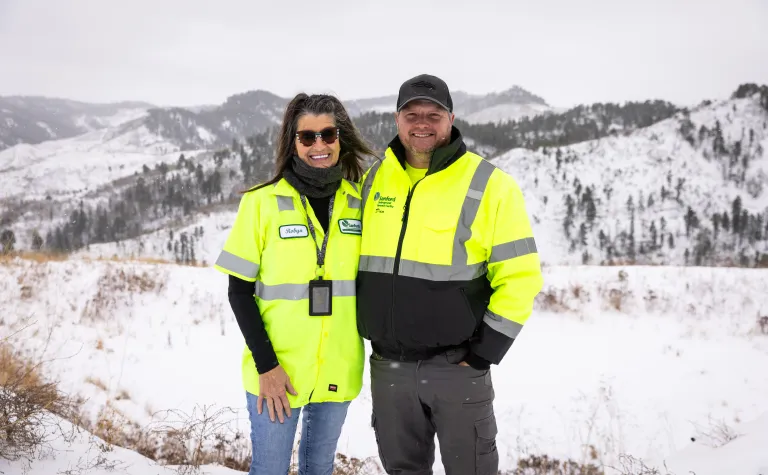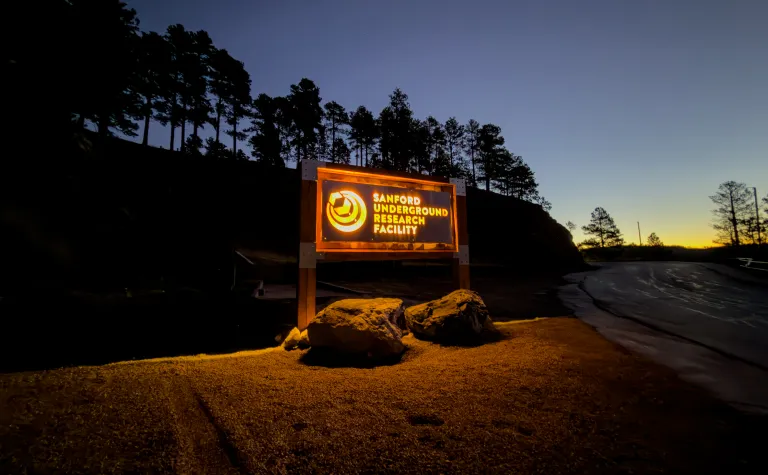Masters of the Slung Load
Master riggers at the Sanford Underground Research Facility (SURF) oversee the complex process of safely transporting heavy equipment and loads between the surface and the deep underground.
“Take your time and triple-check everything.”
That’s the advice Josh Quenzer has for anyone new to master rigging.
His work, alongside many others who assist in rigging operations at SURF, includes the vital task of moving heavy objects between the surface and the underground. Master riggers like Quenzer are akin to the field commanders of the rigging process, ensuring that everything moved up or down the shafts at SURF—from a piece of heavy equipment like a front-end loader to a large but delicate scientific instrument—is delivered safely and without damage.
The process of “slinging equipment” involves hanging anything too big to fit into the 5 by 13-foot rectangular cage down below the deck, where it rides suspended inside the open shaft.

Completing a slung-load at SURF involves a coordinated team effort. This means constant communication between the crew in the headframe and shaft and the hoist operators who manage the vertical movement of the cage.
Quenzer and the other master riggers at SURF point out that there is zero room for error when safely transporting multi-ton loads up or down an open shaft.
“You have a lot of people's lives at hand, and a lot of expensive equipment at hand. It can be stressful, so take your time, slow down and think,” Quenzer said.
Frank Gable is another master rigger at the Ross Shaft. He says it’s the training, experienced crews, and meticulous review details that make each job a success.
“The training we have helps us complete some of the most detailed work that you'll find at SURF,” said Gable.
To date, the crews at SURF have completed 486 slung-loads down the Ross Shaft in support of the Deep Underground Neutrino Experiment (DUNE). Crews run in shifts that allow rigging operations to take place 24 hours a day and 7 days a week. Weekends, however, often provide the best window for transporting large items, since reduced shaft traffic allows more time to lift, assess, and carefully move heavy loads.
“Sometimes a chassis, like a forklift, or manlift, or whatever we're doing, will go smooth and it's two hours. Sometimes we have a delay trying to lift it because we can't get it to hang straight and that can take more time. We don't have designated cage times on the weekends, so that’s our time for this work,” Quenzer said.
Traffic in the Ross Shaft is about to increase dramatically as construction of the DUNE cryostats commences early next year. Each of the two massive cryostats includes about 2,500 tons of steel and, once complete, will stand 216 feet long, 62 feet wide, and 60 feet high. Ross Shaft crews will be involved in delivering 2,100 structural elements in total during cryostat construction. While not every piece will be slung, nearly all will require the expertise of master riggers.
“We will have several hundred critical lifts related to DUNE with rigging on each of the beams, it’s going to be a lot,” said Jeff Barthel, one of the longtime master riggers at SURF.
Barthel points out that it’s the work of the operations team and the rigging crews who make underground science possible.
“If we can't get stuff on the ground and transported below ground, then we have no value as a science facility. So, what these crews do is among the most important work in the whole lab,” Barthel said.
Safety is the first priority at SURF, and the Ross Shaft rigging crews’ attention to detail contributed to SURF’s milestone of one million hours of work without a lost-time injury. Julie Ewing, director of the Environment, Safety, and Health Department at SURF, emphasized the significance of this achievement.
“Not only have we sent down 486 loads so far, but we’ve also done that safely, and that's quite impressive. I sleep perfectly well, not having to worry about a call in the middle of the night because of these crews and their attention to safety,” Ewing said.
For Frank Gable, the high stakes involved in this work are part of the daily routine.
“For the most part, it's just another day on the job. Once a while, you get a little stressed out about one load or another. But ultimately, you find a way to do it safely,” Gable said.



